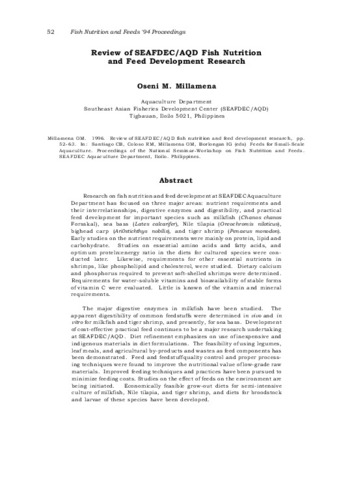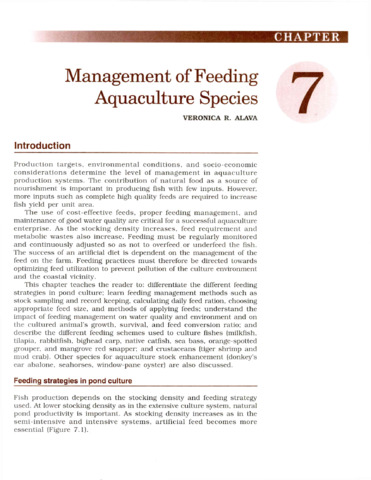Review of SEAFDEC/AQD fish nutrition and feed development research
| dc.contributor.author | Millamena, Oseni M. | |
| dc.date.accessioned | 2011-06-22T09:35:41Z | |
| dc.date.available | 2011-06-22T09:35:41Z | |
| dc.date.issued | 1996 | |
| dc.identifier.citation | Millamena, O.M. (1996). Review of SEAFDEC/AQD fish nutrition and feed development research. In: C.B. Santiago, R.M. Coloso, O.M. Millamena & I.G. Borlongan (Eds.). Feeds for Small-Scale Aaquaculture. Proceedings of the National Seminar-Workshop on Fish Nutrition and Feeds (pp. 52-63). Tigbauan, Iloilo, Philippines : SEAFDEC Aquaculture Department. | en |
| dc.identifier.uri | http://hdl.handle.net/10862/412 | |
| dc.description.abstract | Research on fish nutrition and feed development at SEAFDEC Aquaculture Department has focused on three major areas: nutrient requirements and their interrelationships, digestive enzymes and digestibility, and practical feed development for important species such as milkfish (Chanos chanos Forsskal), sea bass (Lates calcarifer), Nile tilapia (Oreochromis niloticus), bighead carp (Aristichthys nobilis), and tiger shrimp (Penaeus monodon). Early studies on the nutrient requirements were mainly on protein, lipid and carbohydrate. Studies on essential amino acids and fatty acids, and optimum proteln:energy ratio in the diets for cultured species were conducted later. Likewise, requirements for other essential nutrients in shrimps, like phospholipid and cholesterol, were studied. Dietary calcium and phosphorus required to prevent soft-shelled shrimps were determined. Requirements for water-soluble vitamins and bioavailability of stable forms of vitamin C were evaluated. Little is known of the vitamin and mineral requirements.The major digestive enzymes in milkfish have been studied. The apparent digestibility of common feedstuffs were determined in vivo and in vitro for milkfish and tiger shrimp, and presently, for sea bass. Development of cost-effective practical feed continues to be a major research undertaking at SEAFDEC/AQD. Diet refinement emphasizes on use of inexpensive and indigenous materials in diet formulations. The feasibility of using legumes, leaf meals, and agricultural by-products and wastes as feed components has been demonstrated. Feed and feedstuff quality control and proper processing techniques were found to improve the nutritional value of low-grade raw materials. Improved feeding techniques and practices have been pursued to minimize feeding costs. Studies on the effect of feeds on the environment are being initiated. Economically feasible grow-out diets for semi-intensive culture of milkfish, Nile tilapia, and tiger shrimp, and diets for broodstock and larvae of these species have been developed. | en |
| dc.language.iso | en | en |
| dc.publisher | Aquaculture Department, Southeast Asian Fisheries Development Center | en |
| dc.relation.ispartof | In: Santiago, C.B., Coloso, R.M., Millamena, O.M., Borlongan, I.G. (eds.). Feeds for Small-Scale Aquaculture. Proceedings of the National Seminar-Workshop on Fish Nutrition and Feeds, 1-2 June 1994, Tigbauan, Iloilo, Philippines. Iloilo, Philippines: Southeast Asian Fisheries Development Center, Aquaculture Department. pp. 52-63 | en |
| dc.subject | Crustacea | en |
| dc.subject | Philippines | en |
| dc.subject | milkfish | en |
| dc.subject | sea bass | en |
| dc.subject | tilapia | en |
| dc.subject | prawns and shrimps | en |
| dc.subject | Giant tiger shrimp | en |
| dc.subject | Chanos chanos | en |
| dc.subject | Lates calcarifer | en |
| dc.subject | Penaeus monodon | en |
| dc.subject.lcc | VF SP 216 | |
| dc.title | Review of SEAFDEC/AQD fish nutrition and feed development research | en |
| dc.type | Conference paper | en |
| dc.citation.spage | 52 | |
| dc.citation.epage | 63 | |
| dc.subject.asfa | food fish | en |
| dc.subject.asfa | feeds | en |
| dc.subject.asfa | feeding | en |
| dc.subject.asfa | diet | en |
| dc.subject.asfa | digestibility | en |
| dc.subject.asfa | nutritional requirements | en |
| dc.subject.asfa | progress reports | en |
| dc.subject.scientificName | Penaeus monodon | en |
| dc.subject.scientificName | Chanos chanos | |
| dc.subject.scientificName | Lates calcarifer | en |
このアイテムのファイル
このアイテムは次のコレクションに所属しています
-
Feeds for Small-scale Aquaculture [23]
Proceedings of the National Seminar-Workshop on Fish Nutrition and Feeds, Tigbauan, Iloilo, Philippines, 1 -2 June 1994





